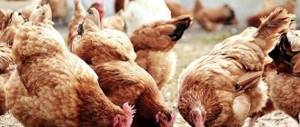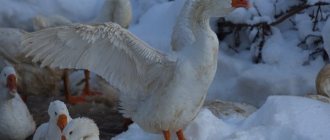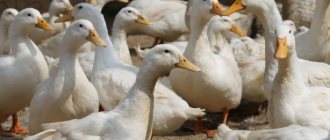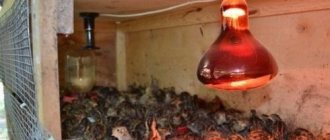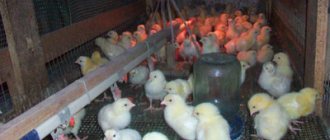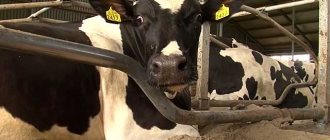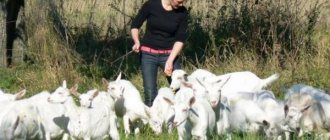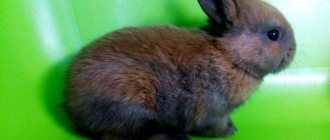How important is lighting for chickens?
In chickens, the visual apparatus is structured differently than in humans. Accordingly, they perceive light differently. So, if a person in light twilight can easily recognize various objects, then for a bird this level of illumination is practically no different from complete darkness. This is the first reason why chickens need lighting. Without it, the hen will not be able to navigate, find food or a nest.
But this is far from the only explanation for why birds need good lighting. It is believed that daylight hours for chickens should last from 12 to 14 hours a day. This value is most favorable for the chicken body. If it drops to the 10 o’clock mark and below, then this is fraught with the following consequences:
- decreased egg production in laying hens;
- later onset of puberty in young animals;
- weight loss;
- thinning the walls of the eggs and reducing their size;
- deterioration of the bird's feather cover;
- weakened immunity;
- slowdown of metabolism, which is the main reason for the decrease in the growth rate of chickens.
It is worth noting that excessively long daylight hours also negatively affect chickens. During the period of complete darkness, during sleep, the bird’s body better absorbs the nutrients and minerals received from food during the day. In addition, it is in complete darkness that the bone tissue of the skeleton is best formed in young animals. Therefore, the 24-hour lighting practiced by some poultry farmers is also erroneous.
Effect of light on birds
Lighting is the main factor providing optimal conditions for the development of chickens. Natural light has a positive effect on the reproductive functions of chickens and the quality of productivity.
In addition to the length of daylight, the spectrum of light plays an important role. This is due to the fact that birds' vision is highly sensitive to the level of light intensity. And also to its duration.
Light hitting the optic nerve causes the hypothalamus (a region of the brain) to produce a substance that stimulates the functions of the pituitary gland (endocrine gland) to produce secretion. The latter, in turn, increases the level of gonadotropic hormones and stimulates the ovaries.
Increasing day length and natural light intensity levels signal to chickens that spring has arrived. They “encourage” them to breed and raise offspring. Thus, natural lighting contributes to the high egg production rate of chickens.
Winter maintenance of laying hens of different breeds in Russia
The further north the region in which it is planned to create a poultry farm, the more relevant are chicken breeds that are resistant to low temperatures.
Pavlovsk chickens
This bird belongs to the decorative breeds. One of the advantages of the breed is valuable meat with excellent organoleptic qualities. An adult weighs about 2.2 kg. The egg production capacity of a laying hen is 120 pcs. 55 gram eggs. Pavlovsk chickens are recommended for a floor housing system, that is, they are not kept in cages.
Pushkinskaya
Advantages of the breed: enviable adaptability to low temperatures, 90% hatchability of young animals, calm disposition, early puberty - at 5-6 months of age. The bird weighs up to 3 kg. For some it’s a plus, but for others it’s a minus – the lack of brooding instinct. An obvious disadvantage of the breed is that if the approach to feeding is incorrect, laying hens begin to quickly gain fat, which negatively affects egg production.
Hercules
The average annual egg production of adult 3.5-kg laying hens does not exceed 200 eggs. The bird is not suitable for a cage system. One of the advantages of the breed is the high safety of young animals.
Bielefelder
Chickens weigh about 4 kg, and the weight of males ranges from 4-5 kg. You can get up to 230 pieces from a laying hen per year. 65-70 gram eggs. As you can see, the Bielefelder is a universal breed from which both egg and meat products are obtained. If you need an omnivorous and calm bird, this is your option.
Icelandic landrace
These are not chickens, but penguins, as they easily adapt even to 40-degree frost. The live weight of a bird that has reached physiological maturity is 2.5 kg. Properly organized feeding and comfortable living conditions for the bird guarantee the production of 220 eggs per year. The breed is notable for the fact that Icelandic laying hens do not stop laying eggs in winter. Safety of young animals is 98%. Chickens are unpretentious in nutrition.
Red Cap
Such chickens do not shine with average daily weight gain and slaughter weight - about 2 kg. But per year they give 180 pieces. 70 gram eggs and from them meat with good organoleptic qualities is obtained.
Faverolles
With a 3.5-kilogram weight, laying hens lay no more than 150 eggs per year. Young animals are characterized by intensive growth. If feeding rates are not controlled, chickens become fat due to overeating. Faverol is the main breeding object recommended for the northern regions.
Temperature range to keep chickens calm
First, let's figure out what temperature chickens can withstand. This indicator depends on the type of bird. And it ranges from -10 to +27 degrees.
At high temperatures, the shells of eggs will become thinner. Their mass becomes smaller. And the number is decreasing. Not to mention that when exposed to heat for a long time, birds drink a lot and eat little. This means they don’t gain weight. In addition, chickens can get heatstroke.
At low temperatures, birds can freeze their paws, wattles and combs. And due to extreme cold, he will catch a cold and die.
On the other hand, there is an opinion that healthy and well-fed chickens tolerate cold well. If you create comfortable conditions in their home, the chickens will calmly go out for a walk even on a frosty day.
But sudden temperature changes definitely have a negative impact on the health of chickens. They become lethargic and susceptible to disease. They refuse to eat.
Walking for chickens in winter
The time has come to build a run adjacent to the southern wall of the chicken coop. If there will be winter keeping of laying hens with clipped wings (or unable to fly high), you can limit yourself to a 1.8-meter fence made of chain-link mesh. A canopy is desirable. If good flyers are chosen as the object of cultivation, it is better to make an aviary.
In any case, containers for food and drinking water are installed on the walking area. Ash or sand baths are required, in which the bird gets rid of parasitic insects. You also need feeders for feeding: fodder chalk, shell rock, etc.
Tip: sow the paddock with perennial short grass (preferably several types of greens). In warm seasons, it will be an excellent source of vitamins and minerals for chickens. By the way, the grass contains vitamin E, which affects the reproductive abilities of laying hens, including their egg laying.
The required area of the chicken coop is calculated taking into account the standard bird stocking density:
- Chickens - 2-3 birds/sq.m.;
- chickens – 5-6 birds/sq.m.
Walking in the cold season
On days when there is no severe frost (up to -10 0C), laying hens should be provided with access to fresh air.
Expert opinionSadchikov Nikolai AlekseevichVeterinarian ornithologist Walking in the fresh air in winter is possible and even necessary. Chickens spend almost the entire winter in a locked room, where large amounts of ammonia accumulate.
We recommend: The main differences between engineered wood and parquet, laminate, solid wood and other floor coverings.
If it’s not bitterly cold outside, then the chickens should be taken out for a walk. The birds will happily peck at the snow, stretch their wings and breathe in oxygen.
About the influence of drafts and cold
Too intense ventilation and constant drafts in summer and winter will not bring health to the bird.
In a draft, the body temperature of chickens gradually decreases, which they are unable to restore on their own.
It must be remembered that nature does not provide for chickens to lay eggs during the cold season.
However, by creating a favorable environment, the chickens’ productivity will not decrease. At a positive temperature of 22-25 degrees, laying hens in winter will produce as many eggs as in summer. And meat birds will continue to gain weight, as they should.
It is recommended to take care in advance of the premises where the chickens will winter in the fall. And then, when the cold comes.
Conditions for keeping laying hens in winter
Many poultry farmers, when choosing a bird breed, choose egg-type ones. Laying hens, as a rule, are not large in size and mainly perform one function - to lay eggs. With proper care, you can produce egg products almost all year round.
For this purpose, certain conditions are created, depending on the place and method of detention. For maximum productivity, laying hens should be provided with the most comfortable conditions possible during the cold season. Recommendations and content rules must be followed.
Insulation
There should be no drafts or too low temperatures in the room where the birds will winter. To do this, chicken coops are additionally insulated so that chickens do not waste strength and energy on maintaining heat. In the northern regions, where during severe winter frosts the temperature in poultry rooms does not exceed -10, it is worth taking care of additional heating sources.
The most common methods:
- stove (“potbelly stove”, Buleryan, classic wood-burning);
- electric heaters;
- infrared lamp;
- thermal insulation of ceilings, walls and floors.
Reference! For bedding material, it is most functional and practical to use straw, peat, spruce branches, and dried plant residues.
To prevent birds' feet from freezing, the layer of litter on the floor should not be less than 15 cm. When droppings fall into deep litter, they decompose and release methane. This is also a source of heat. Do not allow the flooring to get wet. This can cause illness and decreased productivity.
The walls are additionally insulated from the inside or outside. Foil roll materials for interior decoration that reflect heat have proven themselves to be excellent. It is not recommended to use plastic film; it does not add heat, and chickens will quickly peck at it.
Insulation with foam plastic, mineral and stone wool is practiced. The walls, floor and ceiling are covered with plywood, chipboard or fiberboard, and boards. To avoid the formation of fungus and mold, the floor covering should be pre-treated with special products.
The temperature in the chicken coop should not fall below 12-14 degrees. Heating devices must be placed in such a way that the bird cannot be injured or burned.
To artificially increase egg production, fluorescent lamps are installed.
Feeding
Poultry nutrition in winter should be more rational and high in calories. Feed variety increases survival and productivity. The diet in the winter season is somewhat different from the summer. Chickens need additional nutrition, high in carbohydrates, vitamins and microelements.
The most effective nutrition is compound feed, with which the birds will receive a complete, balanced menu. To reduce the cost of feed, prepare it yourself, mixing cereals with other ingredients:
- wheat;
- barley;
- corn;
- bran;
- oats;
- cake;
- bone or fish meal;
- salt;
- lime.
Advice! To maintain maximum egg production, a variety of industrial premixes should be added.
The grain is crushed and also given in its entirety. This way it takes longer to digest, and the livestock receives energy for a longer period.
From time to time it is necessary to diversify the diet, add vegetables: cabbage and a variety of root vegetables. The main requirement is that vegetables must be without signs of rotting. Before feeding poultry, it is advisable to clean them of any remaining soil and, if necessary, wash them with running water. It is useful to introduce fermented milk products into the diet: whey, cottage cheese and skim milk.
Advice! If possible, you should add fish oil to your diet. This improves immunity and prevents diseases.
The bird is fed 2 times a day: in the morning and evening. During severe frosts, food is given even three times a day. To speed up the digestive process, sand and small pebbles must be poured into the chicken coop. Be sure to check the availability of fresh water. It should be preheated. Feeders are cleaned of feed residues to avoid rotting and disease.
We insulate the walls
It is better to build a home for chickens from natural wood. If the climate in the region is mild, then the building is made of boards. In more severe conditions, logs and timber are used.
Depending on the building materials from which the poultry house is made, the method of work and thermal insulation material are chosen. It can be mineral wool, moss, penoplex and much more.
Insulation is carried out on the outside of the building and on the inside. The outer side of the wall is plastered. If cracks appear on the walls after drying, they are covered with clay mortar and sand.
Mineral wool
When using mineral wool, it is necessary to prepare the sheathing of beams in advance. The beams are laid vertically. The distance between them is left 10 mm less than the width of the insulation.
After installation of the lathing, heat and vapor barrier is made using foil. This must be done, since mineral wool tends to absorb moisture. Then mineral wool is placed in the sheathing and secured to the wall.
Penoplex
Penoplex is made on the basis of polystyrene and is produced in the form of dense slabs measuring 120x60 cm. The structure of the material is fine-celled. When joining parts, no gaps are formed, since each element is equipped with a solid L-shaped edge.
The material has high heat-protective properties and does not emit harmful substances or unpleasant odors. Penoplex is used both in regions with harsh climatic conditions and in hot ones, since the material can withstand temperatures from -50 to +75 °C.
The service life of the insulation is about 50 years. The material is toxic when burned and is used only with plaster, which is its disadvantages.
Other ways to insulate the walls of a chicken coop
Polystyrene foam is another thermal insulation material used to insulate the walls of a barn. This is a lightweight material consisting of foamed polystyrene granules.
Each manufacturer has its own density and strength of the material. Antiperen, which is included in some types of foam, has anti-fire properties.
Polystyrene foam will be an excellent choice for insulating the walls of a chicken coop due to its advantageous price-quality ratio
Read also: Broiler cross Cobb-700
Therefore, it is better to insulate walls with a material that includes this component:
- The insulation is glued to the wall from the inside or outside of the room. The surface of the wall must be absolutely flat.
- The material is carefully fixed and plastered.
- The thickness of the sheet for the facade should be 5-6 cm.
Foam plastic has good thermal insulation properties, a long service life, does not require additional waterproofing, and is inexpensive.
Despite all its advantages, this is a fragile material that does not allow air to pass through well. When ignited, it releases harmful substances.
Preparing the chicken coop
During the spring and summer of keeping birds in the chicken coop, garbage accumulates. Often the room becomes infested with parasites. Before winter, it is cleaned of feathers, excrement, dust, cobwebs, old bedding material, and scattered food. Use a scraper to clean nests and perches. Joints between walls and floors, all heavily soiled surfaces and equipment are washed, using a stiff brush if necessary. Metal products are disinfected with a blowtorch.
After cleaning, the chicken coop is treated with antiseptic, fungicidal, acaricidal drugs (Glutex, Delegol, Ecocide S, etc.) against the development of viral and fungal infections, and parasites. For prevention purposes, a minimum concentration is used (usually 0.5% is sufficient). If the room is contaminated, it is increased in accordance with the manufacturer's recommendations. The treatment is carried out in the absence of chickens - they are temporarily relocated. Instead of such products, you can use a regular lime solution (2 kg/10 l).
All cracks are sealed to prevent heat loss during the cold period. After completing the preparatory stage, the floor is covered with fresh bedding, and all equipment is brought inside. The nests are covered with straw.
No more than 5 laying hens can be placed per 1 sq.m - with a high stocking density, stress occurs, which provokes pecking and a decrease in egg production.
How to insulate a chicken coop with foam plastic
Overwintering chickens in a garage can be a fun one-time experience, but people who are serious about raising poultry are wondering how to build a permanent chicken coop.
A member of our portal 1974Sopa1974, on the eve of winter, urgently built a small poultry house from cinder block 4x2.5 meters, 2.2 m high. The ceiling is insulated, lined with fiberboard and painted. Broilers and quails will winter in the poultry house, and the task is to insulate it from the inside without greatly reducing the area.
I think I can allow 5cm on each wall.
Despite the fact that many participants on our portal believe that a chicken coop should only be insulated from the inside, internal insulation with foam plastic shows good results. It does not get wet, although it has two disadvantages:
- The chickens peck at him.
- Mice live in it.
Read also: Breeds of the most unpretentious chickens: meat, laying hens
Therefore, the foam is either plastered or protected in some other way.
Plaster does not stick well to cement, so a member of our portal Plotnikkk suggests the following plan of action:
- put the foam on the ground, prime it with any primer;
- immediately apply a layer of cement plaster;
- after three days we fix the plastered foam plastic to the wall of the chicken coop with “mushrooms”;
- We fill the gaps between the sheets of polystyrene foam with polyurethane foam;
- Once again we plaster everything well, leveling the walls and closing the joints;
- We whitewash the walls of the chicken coop with lime.
Chickens will not be able to peck at the foam protected by plaster, and mice will not get into it.
And here is the composition of a chicken coop wall sandwich using polystyrene foam, which was made by FORUMHOUSE aib participant. From inside to outside: plywood painted with oil paint (3 mm), polystyrene foam (10 pieces), edged board (20 pieces). The outside of the chicken coop is covered with galvanized iron. The chicken coop has been in service since 1991, the heater is turned on only in severe frosts, below -25 degrees.
Microclimate in the chicken coop
Disinfection, sealing all cracks, a thick layer of bedding is only the first stage in creating an optimal microclimate. Chickens need to be provided with a suitable day length. The room must have high-quality air exchange (removal of exhaust air, constant supply of fresh air).
Temperature
To ensure high productivity, it is necessary to maintain the temperature in the chicken coop at +12...+18 °C. A slight decrease in temperature is not critical, but this parameter still needs to be controlled - already at -5°C productivity drops by 15%.
For additional heating, infrared, gas, electric heaters, or wood-burning (peat) stoves are used.
The first ones are considered the most effective and safe - they are used:
- IR lamps;
- IR film.
The advantage of lamps is the combination of two functions at once (heating and lighting). When operating such a device, no oxygen is burned. Efficiency reaches 98%. To heat 10 square meters, 250 W is enough.
Insulation methods
Insulating a chicken coop means covering the walls and ceilings with materials with low thermal conductivity. Heating is important when keeping chickens in the country in winter. You can use roll, sheet, or bulk insulation.
The following are popular:
- Styrofoam;
- Mineral wool in slabs and rolls;
- Expanded clay;
- Sawdust and shavings;
- Arbolit;
- Adobe.
The insulation process is simple, but requires materials and free time. It is important to know that external wall insulation is always more effective than internal insulation.
- To cover the building, a sheathing is built, consisting of vertical posts, the thickness of which must correspond to a similar insulation parameter.
- If it is a sheet of foam plastic with a thickness of 50 mm, the wooden blocks should have a cross-section of the same width.
- Roll, slab or sheet material is placed in the openings between the sheathing posts. Loose is more suitable for insulating the upper and lower floors.
- As the thermal insulation materials are laid, the sheathing is covered with boards or plywood, OSB, or flat slate.
Humidity and air exchange
Ventilation in the room is ensured by supply and exhaust pipes. The lower edge of the supply pipe is located 20 cm from the floor (a retractable damper must be provided for adjustment). The edge of the exhaust pipe should be 5-10 cm from the ceiling. Proper air exchange not only regulates the amount of oxygen, but also helps maintain an optimal humidity level (60-70%).
Lighting
There is a direct relationship between increasing daylight hours and increasing egg production. By providing additional lighting for just 2-3 hours, productivity levels can increase by 25-30%.
- For normal well-being and high productivity of chickens, access to light must be provided in the room for 8–10 hours a day. The recommended illumination level is 20 lux. To ensure this, you can use conventional and energy-saving incandescent lamps with a power of 60 W.
- Lamps are placed at a height of 1.8–2 m from the floor level. Luminescent ones can be installed higher or lower, depending on their power. It is beneficial to use infrared lamps, which will simultaneously heat the chicken coop.
- The best way to provide chickens with natural light is to have windows that are covered with shutters from the outside. This is important in winter, as it will help keep the room warm. The need for additional lighting in the poultry house arises from October to April-May, depending on the region of residence.
We recommend: How to easily remove old paint from metal
Similar publications Features of the light regime for broilers
Apr 28, 2020
What to feed broiler chickens at home with...
Apr 26, 2020
Chicken coop heating lamp
The maximum egg production of chickens is observed if the daylight hours are 14-18 hours. In winter, such indicators can only be achieved with the help of artificial lighting (Figure 3). It should be borne in mind that only fluorescent lamps should be used to illuminate the chicken coop, since ordinary incandescent lamps will not be able to give the desired effect. They are recommended to be turned on from 6 to 9 am and from 17 to 20 pm.
Note: It should be borne in mind that chickens are very susceptible to stress, and a sudden power outage can reduce their egg production. If you live in a region with frequent power outages, you should consider having a backup power source.
The use of lamps can be useful not only for extending daylight hours, but also for heating the poultry house, but for this purpose it is better to use infrared light devices. Naturally, all equipment must be positioned in such a way that the room is evenly illuminated and heated, and birds cannot reach the lamps.
Insulation requirements
Peculiarities:
- The thickness of the walls with insulation is 10–20 cm (depending on the region).
- Eliminating the possibility of predators entering the premises by concreting the floor or upholstering surfaces with a fine-mesh metal grid.
- Forced ventilation device or installation of vents.
- Elimination of cracks using polyurethane foam, tow, mineral wool.
With 10 cm of wall insulation, no cracks and the presence of a thick bedding of hay and sawdust, the temperature in the chicken coop in winter is maintained at +10°C. Additional heating is required only in severe frosts.
How to Convert a Shed
When keeping chickens at your dacha in winter, you can use a regular barn. This is convenient if there is no permanent chicken coop.
Determine a separate place in the barn for chickens at the rate of 2-3 chickens per 1 m². Fence off the selected area to prevent birds from leaving on their own.
Inspect the floor. If it is concrete, stone, earthen, you cannot do without wooden flooring. After making the floor, insulate it as in a regular chicken coop and lay down bedding.
Set up perches and nests. The minimum distance to the floor is 60 cm. It is better to make nests closed.
Otherwise, prepare the designated area as you would in a regular chicken coop. Insulate walls, windows and doors. Install feeders and waterers. Make a ventilation system, lighting and heating.
Feeding chickens in winter at home
Specifics of winter feeding (basic diet, vitamin and mineral supplements, feed preparation rules, feeding rules)
Preparing a chicken coop for winter is an important undertaking, but another factor that increases the productivity of chickens in winter is a complete and balanced diet. In order for poultry to have all the necessary minerals and vitamins in their daily diet in winter, some feeds must be stocked up in the summer.
In winter, these individuals require a large amount of energy for heating, so most of their nutrients are spent on this. And if you do not provide the birds with proper nutrition during the winter, they will not only stop laying eggs, but their reproductive age may sharply decrease.
Diet features
The main task of the poultry farmer is to saturate the chickens’ body with all the necessary substances for the formation of eggs and maintaining immunity. To improve performance, use complete feeds that are balanced in all vitamins and amino acids.
- Stern
- Recipes
- Supplements
Compound feed pk-1 Description of feed for egg breeds. Instructions for feeding laying hens Read Compound feed pk-2 and pk-3 Mineral and vitamin compositions, feeding standards Read Compound feed pk-4 Used for feeding laying hens aged 15-17 weeks Read Compound feed pk-5 Composition and instructions for feeding broiler chickens Read Purina® Pros Important differences from the previous line, application patterns Start, Growth, Finish Read Barley and wheat for laying hens Sprouting and steaming barley and wheat for chickens: how to do it correctly and how to give it to laying hens Read Wheat for broilers Rules for feeding broiler chickens wheat. Dosage for chickens from the second day of life and adult birds Read Mash Preparing mash for broilers at home Read Rice and buckwheat How and in what form you can use rice and buckwheat to feed chickens. Standards for adult birds and chickens Read Bread What kind of bread can be fed to chickens and how to do it correctly Read Fish The product is given in limited quantities: excess feeding can cause serious harm to the bird Read Chalk Chalk as a food additive for chicken feed. Feeding standards for chickens, young animals and laying hens Read Meat and bone meal Meat and bone meal is a mandatory additive for feeding chickens, containing protein and fats of animal origin Read Fish oil How to give fish oil to chickens, laying hens and broilers. What are the benefits of the drug and are there any contraindications Read Limestone Limestone (dolomite) flour in the diet of chickens. Advantage over chalk and feed shell Read Salt Daily dosage of salt for adult birds and young animals and cases of undesirable use Read
Diet for laying hens in winter
In winter, the daily diet of the livestock should consist of:
- High-quality feed. This product can be purchased or prepared at home. The main requirements for this food are that it must contain the largest amount of minerals and vitamins.
- Premixes and vitamins. Cereal crops alone will not provide livestock with all the necessary nutrients. Therefore, premixes and a special vitamin complex for poultry are usually added to the feed. Minerals and animal feed are also added to this food.
- Wet mash. This food is also nutritious and beneficial for laying hens - it is rich in vitamins and minerals. You need to put fresh and warm mash into the feeders!
- Cereals and legumes. In winter, chickens need: corn, wheat, barley, oats. Cake, sprats, fish and bone meal, as well as table salt and chalk are added to the grains. Grains should not be crushed before feeding to poultry - whole grains take longer to digest in the stomachs of the livestock and gradually supply the chickens with the necessary nutrients.
Diet of laying hens in winter
In winter, the following diet is required:
- feed the bird twice a day;
- in the morning they give mash;
- in the evening – feed and grain.
Separately should be containers with small pebbles (or pebbles), coarse sand, crushed shell rock. These components are required by chickens in order to improve the digestion of food in their stomachs.
Preparing drinking bowls
Water should be freely available to the birds throughout the day. It is changed regularly at least once a day, or when it gets dirty. The drinking bowls themselves should be disinfected once every 7 days with a weak solution of potassium permanganate.
Drinking water must be warm, otherwise chickens may develop colds. To do this, many farmers use special heated drinking bowls in which the water does not cool down. The simplest way to heat water is a regular boiler, which is lowered into a drinking bowl and the water is heated to the desired temperature.
You can also purchase a heated drinking bowl in specialized stores or online. In this case, the water for poultry will always be warm, which is important for the health of the livestock.
We recommend: Installing a polycarbonate greenhouse: choosing a location, foundation material, installation
Additional recommendations
When keeping laying hens, it is important to protect them from specific factors that arise in winter - birds should not be allowed to come into contact with heating surfaces or electrical wiring. When using gas appliances for heating, forced ventilation must be provided. Wood stoves can be a fire hazard - do not allow sparks to touch the bedding.
Laying hens lay well in winter, provided that the optimal length of daylight hours is maintained. If the power goes out frequently, it is worth installing a generator.
Be sure to place containers with a mixture of ash and sand in the chicken coop and in the walking area - dry baths serve to prevent the appearance of parasites. To grind food in the gizzard, chickens need fine gravel and sand.
The farmer decides what is best to feed laying hens in winter and what additives to introduce into the diet by observing the behavior of the birds. If they peck at the laid eggs, then you need to increase the amount of food of animal origin (fish waste, meat and bone meal, cottage cheese, fermented milk products). If the shell is weak, you will have to increase the calcium level. It will be possible to maintain egg production at a stable level by creating a favorable microclimate in the poultry house.
- Related Posts
- Purina feed for chickens
- Minorca chicken breed
- Hamburg
- Bantam chicken breed
- Redbrown chicken breed
- Tetracycline for chickens
Types of lamps used
When creating an artificial lighting system in a chicken coop, the type of lamp the breeder chooses plays a big role. There are many variations of such products on the market. But most often in poultry houses fluorescent, diode or incandescent lamps are used. Each type has its own advantages and disadvantages.
Incandescent lamps
This option is most common in chicken coops. Incandescent lamps have a minimal cost, are sold at any hardware store, and are easy to install and dismantle if necessary. In addition, such a product does not require special disposal conditions, since it does not contain substances harmful to health.
One of the disadvantages of incandescent lamps is the fragility of the product.
Luminescent
Fluorescent lamps are also often used in domestic and industrial poultry houses. Such light bulbs are popular due to the following advantages:
- ease of installation;
- minimal energy consumption;
- longer service life;
- the ability to adjust the glow level if you buy a special regulator in parallel with the lamp.
The disadvantages of the device include:
- the presence of mercury vapor in the tubes, due to which the lamps are not suitable for normal home disposal;
- quite high cost;
- less suitable, in comparison with incandescent lamps, light spectrum for chickens.
In addition, it is worth noting that when illuminated, such lamps flicker slightly, which can cause some discomfort in chickens.
LED
LED lamps are gradually replacing all other types of lamps from the market. The reason for this is the following advantages of the product:
- ease of installation;
- long service life (several years);
- minimal energy consumption;
- optimal color spectrum that has a beneficial effect on chickens.
As for the disadvantages of such products, they note only the high cost of the light bulb. But it pays for its cost in the shortest possible time due to serious energy savings.
Increased productivity in cold weather
As soon as the birds have molted and their feathers have changed, you can begin organizing winter care for your chickens to increase egg production. Laying hens begin to lay fewer eggs because... Their instinct for procreation is triggered in the spring. Organizing an artificial spring will help preserve egg production.
In winter, it is better to keep laying hens in a warm room where the air temperature does not fall below 15 ℃. This will help increase productivity by 40%. hens in the winter hut at home are illuminated for no more than 14 hours. Keeping chickens in winter with longer additional lighting reduces life expectancy. In some cases, extended daylight hours lead to premature molting. Then the chickens completely lose the ability to lay eggs and die 1-2 years earlier.
Wintering domestic chickens without loss of productive qualities is possible by installing a special device - a rheostat that controls the brightness of the lighting. This will allow the bird to roost in time before dark. Special sensors vary the light from yellow to orange to night lighting.
Another way to increase productivity is feeding with greens. This option is suitable for those who have a winter greenhouse. You can sow grass and feed it to your chickens year-round. The fattening technique increases egg production by almost 50%.
Reduce the number of chickens to 1 chicken per sq.m. area. Chickens do not lay eggs well when overcrowded and are more likely to die from disease. To lay eggs, they need privacy, and with a large population this is difficult to achieve.
How do chickens cope with the cold?
Caring for chickens in winter must be thorough. They do not tolerate low temperatures well. They begin to hurt and fade over time.
At temperatures below -10 degrees, chickens suffer from frostbite on their extremities with combs and earrings.
Any health problems have a negative impact on productivity. Birds begin to lay eggs worse. Or they stop altogether. In advanced cases, they become exhausted and die.
Proper maintenance of laying hens in winter will help avoid problems. And if initially only strong, healthy and young individuals were left, then you will receive eggs in the same quantities.
Cleanliness is the key...
In areas with harsh winters, it is advisable to include in the chicken coop plan an additional room into which the birds are transferred on cleaning and disinfection days. Cleaning includes not only cleaning the structural elements of the room and equipment, but also mixing or replacing the bedding.
When the underlay material is completely changed, the floor is disinfected before forming a new layer of underlay. In general, in winter it is better to refuse to completely replace the litter, as this leads to a change in the microflora, which is fraught with various pathologies.
How to increase egg production of chickens in winter
To maintain the productivity indicators of laying hens at the current level, improve their vitamin nutrition by including a premix in the diet. Many people mistakenly believe that such supplements are full of hormones, growth stimulants, preservatives and other chemicals. In fact, premixes are sources of purely natural nutrients: protein compounds and biologically active substances.
As the practice of established chicken breeders has shown, the productivity of laying hens is positively affected by feeding dried seaweed, probiotics, including apple cider vinegar, preparations with vitamin A and tocopherol, and vitamins B and D in the diet.
There are a lot of vitamins and minerals in rose hips, red rowan, chestnuts, and acorns. Why not set aside time in the fall to collect and dry them.
Winter maintenance of laying hens in Russia is quite troublesome. But it's worth it. If possible, consider keeping chickens on Netto-Plast deep litter (sawdust + bacteria): the chicken coop is dry, warm in winter, no smell, no flies and cleaning every 3 years!
Factors affecting egg production of chickens in winter
Winter leads to a decrease in natural biorhythms in chickens. Egg production is also affected by a winter drop in temperature and a reduction in daylight hours. Vitamin deficiency and lack of plant and protein foods have a negative effect. Proper care, lack of stress, balanced nutrition helps to significantly extend the period of egg production and receive fresh eggs almost all winter.
Keeping laying hens is becoming easier and more profitable every day. New, more productive breeds are being developed, effective, balanced feeds and various additives are appearing. Manufacturers offer automated poultry care systems. New building materials are making it easier to build chicken coops. As a result, the number of poultry houses involved in breeding laying hens is increasing. Join us and you will always have fresh homemade eggs on your table.
At what temperature do chickens lay eggs?
The temperature in the home of poultry should be maintained at +23...+25 degrees Celsius. It is under such conditions that chickens are able to maintain their productivity. To ensure such a temperature, it will be necessary to insulate the room and install artificial heating sources.
A temperature drop below +15 °C leads to a decrease in the level of egg production, below +5 °C - to its complete stop.
Did you know? Despite the widespread belief about the small brain size and low mental abilities of chickens, scientists claim that they are able to remember about 100 human faces, navigate time, recognize the owner and their neighbors in the chicken coop.
